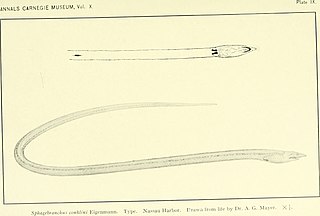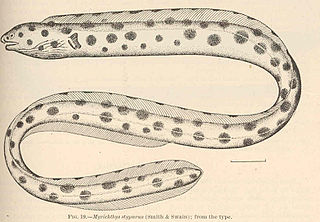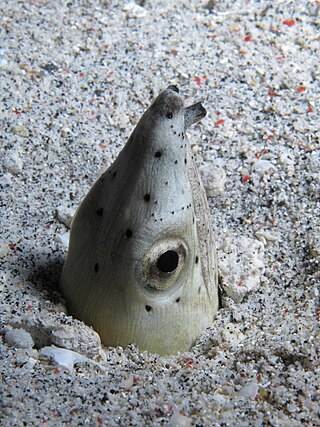
Ophichthidae is a family of fish in the order Anguilliformes, commonly known as the snake eels. The term "Ophichthidae" comes from Greek ophis ("serpent") and ichthys ("fish"). Snake eels are also burrowing eels. They are named for their physical appearance, as they have long, cylindrical, snake-like bodies. This family is found worldwide in tropical to warm temperate waters. They inhabit a wide range of habitats, from coastal shallows and even rivers, to depths below 800 m (2,600 ft). Most species are bottom dwellers, hiding in mud or sand to capture their prey of crustaceans and small fish, but some are pelagic.

Brachysomophis is a genus of eels in the snake eel family Ophichthidae.
Gnathophis nystromi is an eel in the family Congridae. It was described by David Starr Jordan and John Otterbein Snyder in 1901, originally under the genus Leptocephalus. It contains two subspecies, Gnathophis nystromi nystromi, and Gnathophis nystromi ginanago, which was described by Hirotoshi Asano in 1958, originally under the genus Rhynchocymba.

Brachysomophis cirrocheilos, also known as the stargazer snake eel, is a benthic marine fish belonging to the family Ophichthidae. The stargazer snake eel is a large fish which grows up to 159 cm (63 in) long.
The Pacific worm eel is an eel in the family Ophichthidae. It was described by David Starr Jordan and Charles Henry Gilbert in 1883. It is a marine, subtropical eel which is known from the eastern central and southeastern Pacific Ocean, including California, USA, Colombia, Costa Rica, El Salvador, Ecuador, Honduras, Mexico, Guatemala, Panama, Nicaragua, and Peru. It dwells at a depth range of 1 to 12 metres, and inhabits sand and mud sediments. Unlike many species of eel, it does not form burrows. Males can reach a maximum total length of 46 centimetres.
Apterichtus kendalli, the Western Atlantic finless eel or finless eel, is an eel in the family Ophichthidae. It was described by Charles Henry Gilbert in 1891. It is a marine, subtropical eel which is known from the western and eastern Atlantic Ocean, including North Carolina, USA; the western Bahamas, Venezuela, and St. Helena Island. It dwells at a depth range of 3 to 400 metres, and forms burrows in sandy sediments on the continental shelf. Males can reach a maximum total length of 60 centimetres (24 in).
Brachysomophis atlanticus is an eel in the family Ophichthidae. It was described by Jacques Blache and Luiz Vieria Caldas Saldanha in 1972. It is a tropical, marine eel which is known from the eastern Atlantic Ocean, including Senegal and the Gulf of Guinea. It inhabits the continental shelf, and makes burrows in sand and mud. Males can reach a maximum total length of 27.3 centimetres.

The crocodile snake eel is an eel in the family Ophichthidae. It was described by Edward Turner Bennett in 1833. It is a tropical, marine eel which is known from the Indo-Pacific, including East Africa, the Society Islands, Japan, and Australia. Males can reach a maximum total length of 120 centimetres. It dwells at a depth range of 0–30 metres, and inhabits coral reefs. It forms burrows in sand and lies in wait to ambush prey, leaving only its eyes exposed. Its diet consists of octopuses, species of Calcarina, and finfish.
Brachysomophis longipinnis is an eel in the family Ophichthidae. It was described by John E. McCosker and John Ernest Randall in 2001. It is a marine, temperate water-dwelling eel which is known from a single specimen collected from Taiwan, in the northwestern Pacific Ocean. It is known to dwell at a depth of 50 metres, and is known to reach a total length of 42.1 centimetres.
Brachysomophis porphyreus is an eel in the family Ophichthidae. It was described by Coenraad Jacob Temminck and Hermann Schlegel in 1846. It is a marine, temperate water-dwelling eel which is known from the northwestern Pacific Ocean, including Taiwan, China, Japan, and Korea. It is known to dwell at a depth of 20 metres, and makes burrows in mud, nearly deep enough to cover itself completely. Males can reach a maximum total length of 130 centimetres.
The turret snake eel is an eel in the family Ophichthidae. It was described by John E. McCosker and John Ernest Randall in 2001. It is a marine, tropical eel which is known from the Indo-Western Pacific, including Indonesia and the Philippines. It dwells at a depth range of 14 to 18 metres, and inhabits sand and reefs. Males can reach a maximum total length of 13.9 centimetres (5.5 in).

Callechelys lutea, the freckled snake eel or yellow-spotted snake eel, is an eel in the family Ophichthidae. It was described by John Otterbein Snyder in 1904.

The Surf eel is an eel in the family Ophichthidae. It was described by Barton Warren Evermann and Millard Caleb Marsh in 1900, originally under the genus Sphagebranchus. It is a marine, tropical eel which is known from the western and eastern Atlantic Ocean, including Bermuda, the Bahamas, Florida, USA; Puerto Rico, the Virgin Islands, northern South America, and St. Helena Island. It dwells at a maximum depth of 35 metres (115 ft), most often between 5 and 15 metres, and forms burrows in sand bottoms in surf areas, from which its common name is derived. Males can reach a maximum total length of 45 centimetres (18 in).

The saddled snake-eel is an eel in the family Ophichthidae. It was described by George Tradescant Lay and Edward Turner Bennett in 1839, originally under the genus Ophisurus. It is a marine, tropical eel which is known from the Indo-Pacific and southeastern Atlantic Ocean, including East and South Africa, the Hawaiian Islands, the Marquesan Islands, the Mangaréva islands, Japan, and Australia. It dwells at a depth range of 0 to 70 metres, most often around 0 to 10 metres, and inhabits lagoons and reefs, in which it forms burrows in beds of seagrass and sandy areas. Males can reach a maximum total length of 66 centimetres (2.17 ft).

The magnificent snake eel, also known as the Hawaiian spotted snake eel, is an eel in the family Ophichthidae. It was described by Charles Conrad Abbott in 1860, originally under the genus Pisoodonophis. It is a marine, tropical eel which is known from the eastern central Pacific Ocean, including the Hawaiian Islands, the Leeward Islands, Johnston Island, and Midway Atoll. It dwells at a depth range of 1 to 262 metres, and inhabits crevices, sand and rocks. Males can reach a maximum total length of 78 centimetres (31 in).

The highfin snake eel (Ophichthus altipennis, also known as the blackfin snake eel or the black-finned snake eel, is an eel in the family Ophichthidae. It was described by Johann Jakob Kaup in 1856, originally under the genus Microdonophis. It is a marine, tropical eel known from the eastern Indian Ocean and northwestern and western central Pacific Ocean, including Australia, French Polynesia, Indonesia, Japan, the Marshall Islands, Malaysia, the Philippines, and Papua New Guinea. It dwells at a depth range of 0 to 40 m, and forms burrows in soft inshore sand sediments. Males can reach a maximum total length of 103 cm.

The Napoleon snake eel is an eel in the family Ophichthidae. It was described by Johann Jakob Kaup in 1856, originally under the genus Poecilocephalus. It is a marine, tropical eel which is known from the Indo-Pacific, including Durban, South Africa, Mauritius, Indonesia, Japan, Australia, and the Penghu Islands. It is known to dwell at a depth of 20 metres (66 ft), and inhabits lagoons and reefs; it forms solitary burrows in sand sediments. Males can reach a maximum total length of 75 centimetres (30 in).

The Pacific snake eel is an eel in the family Ophichthidae. It was described by Johann Jakob Kaup in 1856, originally under the genus Muraenopsis. It is a marine, subtropical eel which is known from the eastern central and southeastern Pacific Ocean, including California, USA, Peru, the Gulf of California, Mexico, the Galapagos Islands, Colombia, Ecuador, Costa Rica, El Salvador, Honduras, Guatemala, Nicaragua, and Panama. It dwells at a maximum depth of 155 metres (509 ft), and forms burrows in mud and sand sediments. Males can reach a maximum total length of 115 centimetres (45 in), but more commonly reach a TL of 80 centimetres (31 in).
The yellow snake eel is an eel in the family Ophichthidae. It was described by David Starr Jordan and Charles Henry Gilbert in 1882. It is a marine, subtropical eel known from the eastern central and southeastern Pacific Ocean, including Chile, Costa Rica, Colombia, Ecuador, Guatemala, El Salvador, Honduras, Nicaragua, Mexico, Panama, Peru, and the United States. It dwells at a depth range of 1 to 110 m, and forms burrows in rocky and sandy regions. Males can reach a maximum total length of 98 cm (39 in), but more commonly reach a length of 50 cm (20 in).

The Galapagos snake eel is an eel in the family Ophichthidae. It was described by David Starr Jordan and Charles Harvey Bollman in 1890. It is a marine, tropical eel which is known from the eastern central and southeastern Pacific Ocean, including Colombia, the Gulf of California, Costa Rica, the Galapagos Islands in Ecuador, and Clarion Island in the Revillagigedo Archipelago in Mexico. It dwells at a depth range of 3 to 80 metres, and inhabits reefs, preferring to live in areas bearing a mixture of boulders, gravel and sand. Males can reach a maximum total length of 71 centimetres (28 in).













